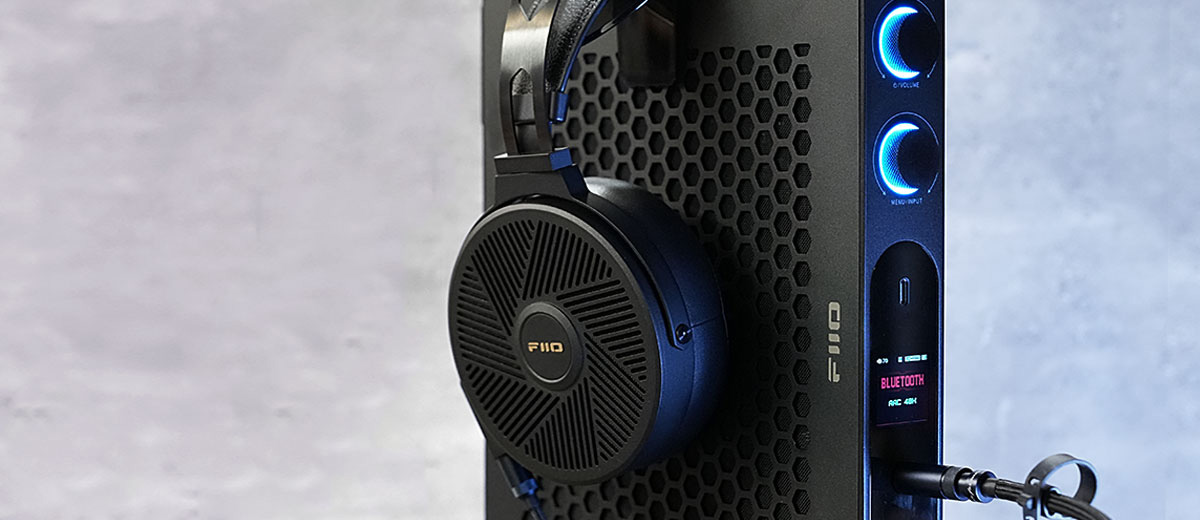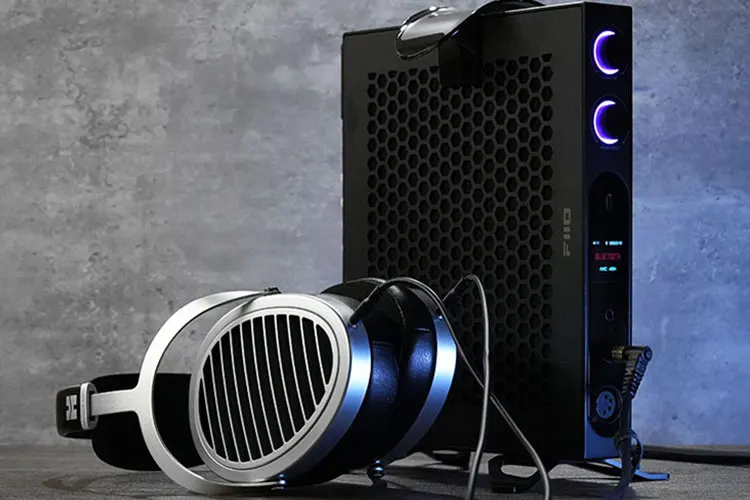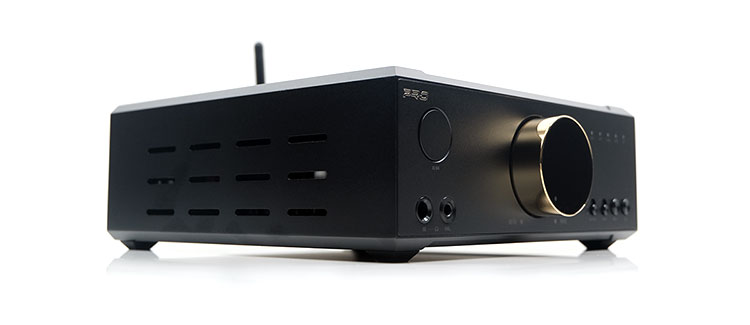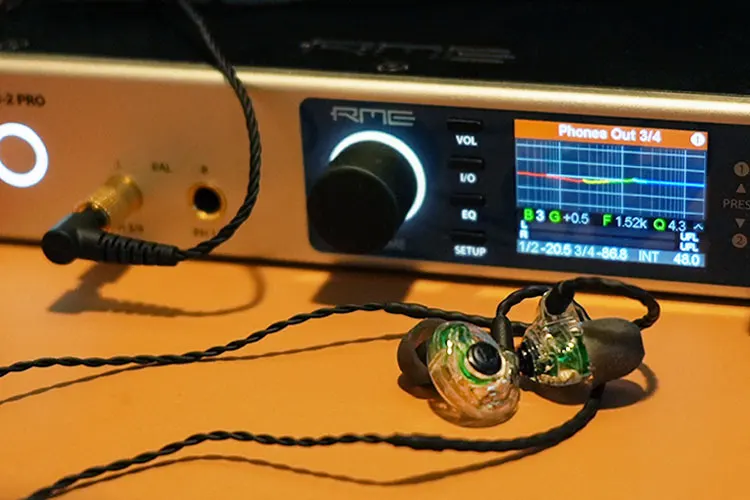Synergy
Efficiency
The K19’s A-weighted noise floor for the Lineout is below 1.6μV and<3.5μV for Phone out. For its balanced lineout, it is 2μV and for the balanced headphone output, it is<6μV. This suggests the noise floor is pretty low and matches the expectation for a flagship decoder.
In practice, the K19 is quiet with different sources though you can find it responsive to the power quality. You may occasionally hear a very faint hiss when using a dirty power source connected to the PC and routers. With a filtered extender the background is darker, which enhances the dynamics.
Power
At high gain, the K19 remains quiet with sensitive gears like the FiiO FT5 or the HIFIMAN Ananda Nano, and there are 5 levels of gain catering to different pairings, which will also slightly alter the tone.
At Ultra High gain there is decent control while more treble details are pushed forward, and the lowest gain sounds slightly softer.
FiiO has claimed that the K19 can power most headphones, including current demanding planars and the high-impedance HD 800 which normally requires very strong amping.
I can quite confirm that the K19 is indeed very powerful and versatile, sounding dynamics at all times. More so if you are willing to give the 31-band equalizer a try.
The equalizing experience is delightful given that there is no detectable distortion and unnaturalness, and this is what traditional amplifiers or decoders might not easily achieve.
Headphone Pairings
The high output power and precise gain level control give the K19 advantages in pairing with different gears from sensitive IEMs to the more demanding, insensitive planar cans. Be reminded the balanced output is much more powerful and sounds much firmer and more expansive.
With the HIFIMAN Ananda Nano, it sounds full and dynamic even on low or mid gain and the output is quite natural without sounding overpowered or skewed. The stage rendered is also wide and spacious with delicate detail retrieval.
Pushing to higher gain gives the vocal more edges and presence, without overly bringing out the sibilance tones. With the FiiO FT5, a similar result is obtained. The bass sounds very firm and the transients are well elaborated.
You can hear in common the bass sounds very firm and dense across different headphones, even with insensitive planars like the Moondrop Venus, which punches solidly in the bass on the K19 and achieves a very fast and clean response, with elaborated vocal harmonics.
The high output power also works well with older cans, for example, the HD 600, which sounds very open and mellow in the mid-lows on high gain. Pushing the gain further makes it even cleaner and faster, perhaps a bit clinical but very revealing in the vocal range.
IEM Pairings
Pairing with higher impedance IEMs is also beneficial. Testing with the Earsonics SWITCH 300 PRO with an impedance profile ranging from 31.5-41.5Ω, the K19 effortlessly drives it to sound engaging, clean, and full in the lows, giving a good sense of accuracy and air.
The same applies to the Westone Audio MACH 20 which has a fuller presentation, and the pairing sounds very coherent, with satisfactory bass depth and strong dynamics.
In general, it is recommended to use the balanced output for the K19’s optimized performance and it gives a rather neutral response.
You can use the PEQ software to enhance the micro-details and sharpness. This robust equalizing feature can enhance matchability and provide ample room for pairing with different gears.
Select Comparisons
FiiO K9 Pro ESS
Technical
Before the introduction of the K19, FiiO’s flagship device in their desktop decoder and amplifier line was the K9 Pro ESS, though it is now available in both ESS and AKM variants.
The K9 Pro ESS utilizes dual ES9038PRO DAC chips in a fully balanced architecture, supporting up to 32/384kHz and DSD256 decoding.
In comparison, the K19 offers even higher specifications with support for up to 32/768kHz and DSD512 decoding. The K19’s balanced output is nearly four times more powerful than that of the K9 Pro ESS, as indicated by the spec sheet.
The K19 incorporates several notable improvements. It includes an HDMI ARC connection for decoding and upgrades the THX amplifying section to an 8-channel setup, compared to the 4-channel configuration of the K9 Pro ESS.
Additionally, the K19 features a dedicated DSP chipset and clock, upgraded oscillators for the decoding chipset, and supports digital output via optical and coaxial connections.
Unlike the K9 Pro ESS, the K19 supports both DC and AC power options. FiiO has also added ground lift and bidirectional TRIGGER features to the K19, further enhancing its functionality.
Design
The K19 offers a stealthier and lighter design compared to the K9 Pro ESS. It features a screen that allows for easier control of sound settings, without the need to rely on the app. Additionally, the USB-C socket on the faceplate provides more convenient connectivity to USB sources.
One standout feature of the K19 is its additional headphone stand parts, which help save desk space while also protecting the headphones from potential heat dissipation from the DAC due to the spacing, the stand is also much more secure as it is screwed-on.
Despite these advantages, the K9 Pro ESS still maintains a cooler and more distinct design with a golden knob and bold aesthetics, including tilted edges. The K19, on the other hand, showcases more subtle design elements on the side panels and incorporates cooler lighting effects on the knob.
Performance
When comparing the two, it becomes evident that the K19 provides a denser, firmer, and more dynamically defined output for both balanced earphones and headphones.
Even through the single-ended 6.3mm output, the K19 exhibits clear advantages over the K9 Pro ESS in terms of clarity, bass texture, and spaciousness.
The definition is much stronger on the K19 especially when it comes to more demanding loads, and it sounds more organic, with a better sense of control while maintaining a more natural and swiftly articulated output.
With sensitive headphones like the FiiO FT5 planar headphones, K19 shows a noticeable improvement in bass control, extension, and coherence. The bass punches more solidly and you can detect the rumble more easily. There is more resolution and headroom with stronger dynamics when more instruments come into the mix.
When using less sensitive headphones like the Moondrop Venus, the K19 delivers strong dynamics, and a punchier and firmer response on the highest gain.
The K9 Pro ESS also manages to sound dynamic and energetic, but the bass resolution, density, and vocal separation are clearly behind the K19, which also renders the midrange more articulately and natural-sounding.
In addition, the dedicated 31-band PEQ is significantly more advanced. Not only does it allow for more precise frequency points to be corrected, but the result is also more natural, without disturbing the sense of resolution and density.
This improved performance can likely be attributed to the utilization of a dedicated DSP chipset and clock.
RME ADI-2 Pro
Technical
The RME ADI-2 Pro is a highly regarded audio interface and decoder known for its exceptional technical capabilities.
RME places great emphasis on the importance of the clock signal and allows for other devices to serve as the clock master through digital audio connections, such as optical or coaxial ADAT, AES/EBU, or SPDIF digital streams.
For connectivity, the ADI-2 Pro offers a comprehensive range of input and output options. It features balanced XLR, and unbalanced RCA analog inputs/outputs, including an AES digital output.
The ADI-2 Pro is also renowned for its powerful DSP capabilities, making it suitable for professional audio users. These capabilities include advanced features like parametric EQ, convenient bass/treble adjustments, stereo width control, and crossfeed functionality.
It’s important to note that these features are distinct from the digital filters, EQ presets, and the more sophisticated 31-band EQ offered on the K19.
Design
The ADI-2 Pro features a color display and two knobs. However, it’s worth noting that the screen orientation cannot be changed, and it may take more time to understand how to control it compared to the more intuitive controls offered on the K19.
Nevertheless, I wish that FiiO could implement visualizers like those displayed on the ADI-2 Pro.
In contrast, the K19 caters more to consumers than to prosumers or professional users. It offers 4.4mm and XLR outputs, making it suitable for a wider range of audiophile headphones and audio equipment.
Additionally, the ability to position the device upright makes it ideal for more limiting desktop or home spaces.
Performance
The RME ADI-2 Pro has been my benchmark gear for quite some time as it sounds very coherent, controlled, and revealing. With a 0.1ohm output impedance rating and 1500mW per channel, it can handle sensitive gear with ease.
With CIEMs and very sensitive IEMs like the Andromeda 2020 or the HiBy Zeta, the ADI-2 Pro sounds smooth, tight in the bass, and less altered especially in the mid-lows allowing the vocal to penetrate through more effortlessly and with better authenticity.
This serves its purpose as a reference grade machine sounding cleaner and more revealing in the upper register.
In comparison, the K19 offers much more power and is reflected in the stage rendered, the power in the bass punch, stage width, and vocal separation.
It allows pairing with more demanding cans and brings out the overtones in the upper frequencies much more clearly, resulting in enhanced detail retrieval and improved transparency.
When using planar headphones in single-ended mode, the K19 exhibits a stronger sense of definition, bass texture, and holographic imaging. While it may perform head-to-head for sensitive IEMs, when the load is more insensitive the K19 has a clear edge sounding more engaging and defined.
Regarding the DSP/PEQ, I am surprised the K19’s 31-band PEQ actually feels more professional and precise than the simpler one found on the RME ADI-2 Pro. It has a cool presentation but isn’t as intuitive as the FiiO UI as it targets more professional users.
The higher number of bands on the FiiO K19 version will allow more precise adjustment while the ADI-2 Pro version allows easier on-screen adjustment showing the adjusted response curve.
Our Verdict
In the competition for higher power and decoding capabilities, FiiO surprised me with the inclusion of various new features, including HDMI ARC functionality and a lossless 31-band equalization feature.
The 8-channel THX amplification seems unleashed under the powerful architecture, making this the most linear and coherent-sounding FiiO device to date. It also provides an excellent foundation for the practical PEQ functionality.
The convertible design and headphone stand clip-on part are thoughtful additions that enhance its functionality.
The FiiO K19 serves as a comprehensive, all-in-one desktop DAC and headphone amplifier for users seeking impressive audio performance, compatibility with consoles and various sources, and who possess a diverse collection of headphones.
FiiO K19 Technical Specifications
- DSP: ADI SHARC+ ADSP-21565
- DAC: 8-channel ES9039SPRO*2
- Headphone amplifier: 8-channel THX AAA 788+
- USB chip: XMOS XU316
- USB decoding support: 768kHz/32bit, DSD512, MQA full decoding
- USB interface: Type-C *3
- Bluetooth chip: QCC5125, Bluetooth 5.1
- Bluetooth codec support: SBC/AAC/aptX/aptX LL/aptX HD/aptX Adaptive/LDAC
- Display: 1.30-inch fully laminated screen (240*240)
- Power output 1: L+R≥2300mW+2300mW (32Ω single-ended, THD+N<1%, Ultra high gain mode)
- Power output 2: L+R≥8000mW+8000mW (32Ω balanced, THD+N<1%, Ultra high gain mode)
- Power output 3: L+R≥270mW+270mW (300Ω single-ended, THD+N<1%, Ultra high gain mode)
- Power output 4: L+R≥1100mW+1100mW (300Ω balanced, THD+N<1%, Ultra high gain mode)
- Power output 5: L+R≥1250mW+1250mW (32Ω single-ended, THD+N<1%, Super high gain mode)
- Power output 6: L+R≥5000mW+5000mW (32Ω balanced, THD+N<1%, Super high gain mode)
- Signal-to-noise ratio: ≥128dB (A-weighted)
- Noise floor 1: LO<6μV (A-weighted); PO<3.5μV (A-weighted)
- Noise floor 2: BAL LO<2μV (A-weighted); BAL<6μV (A-weighted)
- Output impedance: <6Ω (32Ω)
- THD+N: <0002%(1kHz/-6dB@32Ω)
- Weight: About 1800g
- Dimensions: About 250x225x36.7mm






